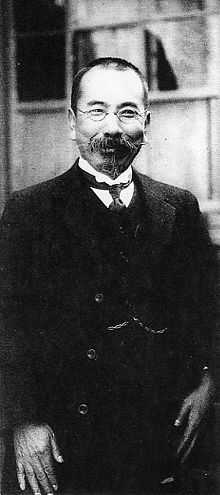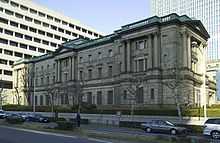Tatsuno Kingo

Tatsuno Kingo (辰野 金吾, October 13, 1854 – 25 March 1919) was a Japanese architect born in Karatsu, Saga Prefecture, Kyushu.
He studied in Japan at the Imperial College of Engineering where he was one of the first to graduate in 1879 under British architect Josiah Conder. He visited England and worked in the office of William Burges in 1881-2.[1] He taught at the University of Tokyo. He created his own firm in 1903.
Early career
After his graduation in 1879, Tatsuno journeyed to London in 1880 to attend London University. During his stay he worked at the office of the Gothic Revivalist William Burges. Unfortunately, Burges died in 1881 during Tatsuno's stay. Before returning to Japan he travelled in France and Italy for a year.[2] During this time he was influenced by the Queen Anne style.
On his return to Tokyo, he taught first at the Imperial College of Engineering before becoming department head at the Tokyo University.
In 1886, he was one of the founders of the forerunner of the Architectural Institute of Japan, the then called "Building Institute". The organisation was based upon the Royal Institute of British Architects and the group met regularly, sponsored lectures and produced Japan's first architectural journal.[3]
Later career

Although his early work was influenced by his travels in Europe with traces of Inigo Jones and Christopher Wren, the Shibusawa Mansion (1888) was influenced by Serlio, Ruskin and Conder's own Venetian styled works. The site, on one of Tokyo's canalways suited itself to a Venetian character.[4]
His ties with Shibusawa Eiichi brought him the commission to design the Bank of Japan in 1890 (completed in 1896). It was first building of its type to be designed by a native Japanese person. Tatsuno immediately set off to Europe for a year to do research for the project, studying amongst other buildings, the Banque Nationale in Brussels by Beyaert and Janssens.[5]
The bank is a three-storey building constructed with reinforced brick faced with stone and has limited use of steel for long spans. Its style is inspired by French Neoclassicism. The original building was square in plan with the banking hall situated immediately behind the porticoed main front.[6]
Tatsuno had a strong influence Japanese colonial architecture - especially in Manchukuo. Connection with construction firms like Okada Engineering, the Association of Japanese Architects (Nihon Kenchiku Gakkai 日本建築学界) or through the new Journal of Manchurian Architecture (Manshu kenchiku zasshi 満州建築雑誌),helped insure that a particular architectural style—that popularized by Tatsuno, sometimes called the Tatsuno style (辰野式) initially became the standard throughout Japanese Manchuria. This involved a somewhat grand interpretation of the style of historical eclecticism that was popular in contemporary Europe.[7]
In 1903 he set up his own office, the first Japanese architect in the country to do so. He died as a result of the 1918 flu pandemic in 1919.
Some buildings


- Bankers' Association Assembly Rooms, Sakamoto-cho, Tokyo (1885)
- Shibusawa Mansion, Kabutocho, Tokyo (1888)
- College of Engineering, Tokyo Imperial University, Hongo (1888)
- The headquarters for the Bank of Japan (1896)
- The first school building of Kyushu Institute of Technology (1909)
- National Sumo Arena, Kuramae, Tokyo (1909)
- The West Japan Industrial Club, Tobata, Kitakyushu (1911)
- Old Yasuda Mail Products, Yahatahigashi-ku, KitaKyushu (1912)
- Manseibashi Station (1912)
- Tōkyō Station (1914)
- Old Hyaku-Sanju Bank Yawata Branch, Yahatahigashi-hu, KitaKyushu (1915)
- Old San-yo Hotel, Kokutestu, Shimonoseki (1923)
Footnotes
- ↑ Finn (1995), p194
- ↑ Stewart (2002), p37
- ↑ Reynolds (2001), p14
- ↑ Stewart (2002), p49
- ↑ Stewart (2002), p54
- ↑ Stewart (2002), p53
- ↑ Sewell, Bill (2004). "Reconsidering the Modern in Japanese History: Modernity in the Service of the Prewar Japanese Empire". Japan Railway & Transport Review (Japan Review) 16: 213–258.
References
- Dallas Finn, Meiji Revisited: The Sites of Victorian Japan, Weatherhill, 1995 ISBN 978-0-8348-0288-9
- Louis Frédéric (translated by Käthe Roth), Japan Encyclopedia, 1996 (2002), ISBN 0-674-00770-0
- Stewart, David B (2002). The Making of a Modern Japanese Architecture, From the Founders to Shinohara and Isozaki. Kodansha International.
- Reynolds, Jonathan M. (2001). Maekawa Kunio and the Emergence of Japanese Modernist Architecture. University of California Press. ISBN 0-520-21495-1.
External links
| Wikimedia Commons has media related to Kingo Tatsuno. |